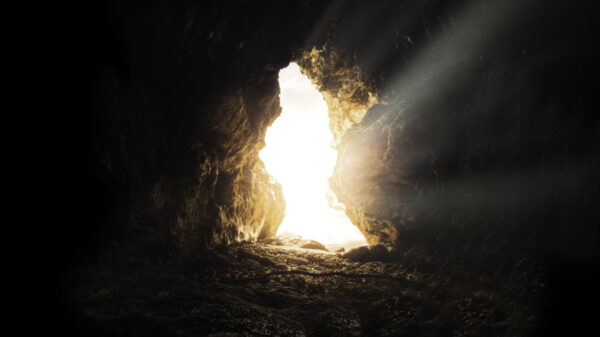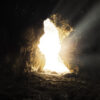Recently, after speaking at large conference, I was approached by a man who asked a question about the shape of crucifixion cross of Jesus. He’d been approached by Jehovah’s Witnesses who challenged the traditional shape of the cross. They argued the Greek word for “cross” (stauros) simply meant an “upright pole”, “upright stake” or “torture stake”. His Jehovah’s Witness visitors claimed Jesus was actually nailed to a straight stake with a single spike through his hands and another through his feet. In my experience with Jehovah’s Witnesses, I’ve also heard them argue the traditional Christian shape of the cross was borrowed from pagan sources and, as a result, it is un-Christian to acknowledge the traditional cross shape in church architecture, worship or adornment. While the Greek words used for the cross in the New Testament are not specific about its shape (“stauros” = stake / pole and “xulon” = timber / tree), there are several evidential clues offered in the scripture to help us understand the true shape of Jesus’ cross.
Before we look at the evidence related to the cross, we need to examine the many ways Roman executed criminals on wooden structures of one kind or another throughout history. Josephus, when writing about the siege of Jerusalem ion 70AD, acknowledged the fact Roman soldiers used a variety of methods and stake shapes to execute their prisoners:
“(The Jews caught outside the walls of Jerusalem) were first whipped, and then tormented with all sorts of tortures, before they died, and were then crucified before the wall of the city … the soldiers, out of the wrath and hatred they bore the Jews, nailed those they caught, one after one way, and another after another, to the crosses, by way of jest” (Josephus, Wars of the Jews, 5.11.1).
In addition, the first-century Roman philosopher, Seneca the Younger, described crucifixions in a variety of ways:
“I see before me crosses not all alike, but differently made by different peoples: some hang a man head downwards, some force a stick upwards through his groin, some stretch out his arms on a forked gibbet” (Seneca the Younger, “To Marcia on Consolation”, in Moral Essays, 6.20).
The Romans typically employed one of four shapes:
I – Crux Simplex
Sometimes they used a single upright stake or post and either nailed or tied their victim (in some cases this may have simply been to the trunk of a tree). With this shape of wood, the victim’s hands could be tied or nailed quite simply with a single piece of rope or a single nail, as many Jehovah’s Witnesses suggest.
T – Crux Commissa
Sometimes the Roman soldiers used a Crux Commissa (“connected cross”). This is also referred to as “St. Anthony’s Cross” or the “Tau Cross” (after the Greek letter “Tau” it resembles). This structure was constructed from a horizontal beam connected at the top of the vertical stake, forming a “T” shape. Victims were nailed to the T with arms outstretched on either side of the horizontal beam. Their feet were either nailed together or separately to the bottom of the vertical post.
+ – Crux Immissa
Similar to the Crux Commissa, this third shape is the traditional form Christians observe for the cross (“Immissa” means “inserted”). This cross was constructed from a vertical stake with a horizontal cross beam (called a “patibulum”) inserted across the upper portion, leaving a “tip” extending above the patibulum. Sometimes this tip was little more than a small extension, resulting in a structure still resembling a “T” more than a “+”. Victims were nailed to the structure with arms outstretched on either side of the patibulum. Their feet were either nailed together or separately to the bottom of the vertical post.
X – Crux Decussata
This “X” shaped cross (also known as “St. Andrew’s Cross”) borrowed its name from the Roman numeral ten (“decussis”). Two wooden planks were fastened together in an X configuration and the victim’s were nailed to the cross with arms outstretched on top ends of the X. Their feet were either nailed or tied separately to the bottom ends of the X.
So, which of these shapes were used for Jesus’ cross? While the data is limited, I do think the traditional shape (the “Crux Immissa”) is the best inference from evidence for the following reasons:
The Limits of Linguistic Evidence:
The Greek words used in the New Testament place no restrictions on which shape we must infer. Like other languages, the original meaning of the terms “stauros” and “xulon” changed over time. Homer, for example, lived sometime between the 12th and 9th Centuries BC. In his day, the term “stauros” simply meant “pole”. But by the time of Christ, the Romans were still using the Greek language even though they modified many of the words to give them broader meaning. The Greeks did not use crucifixion as a form of execution. When the Romans used this method of punishment, they had to modify the existing Greek terminology to suit their purposes. As New Testament Greek scholar, Dr. David Black says:
“(The original meaning of a word) used alone, cannot adequately account for the meaning of a word since meaning is continuously subject to change.… It is therefore mandatory for the New Testament student to know whether the original meaning of a word still exists at a later stage.… Hence it is not legitimate to say that the ‘original’ meaning of a word is its ‘real’ meaning” (David Alan Black Linguistics for Students of New Testament Greek Baker Books, Grand Rapids, 1988, 1995, p.122).
For this reason, Kittel’s Theological Dictionary defines “stauros” in the following way:
“In shape we find three basic forms. The cross was a vertical, pointed stake… or it consisted of an upright with a cross-beam above it… or it consisted of two intersecting beams of equal length…” (Gerhard Kittel, Theological Dictionary of the New Testament: Volume 7, 1971, p. 572).
In order to know precisely which shape of wood was used to crucify Jesus, we need to look at the cumulative case from other evidences.
The Descriptions of Ancient Non-Biblical Sources:
A number of ancient non-Biblical sources eliminate at least one form of the cross (“Crux Simplex”) and make another form (“Crux Decussata”) unlikely. Let’s take a look at them in order of antiquity:
Dionysius of Halicarnassus (60BC to sometime after 7BC)
A Greek historian and teacher of rhetoric who lived at the time of the birth of Jesus, offers the following description of how the condemned were led to execution on what appears to be a “Crux Commissa,” or “Crux Immissa”:
“A Roman citizen of no obscure station, having ordered one of his slaves to be put to death, delivered him to his fellow-slaves to be led away, and in order that his punishment might be witnessed by all, directed them to drag him through the Forum and every other conspicuous part of the city as they whipped him, and that he should go ahead of the procession which the Romans were at that time conducting in honour of the god. The men ordered to lead the slave to his punishment, having stretched out both his arms and fastened them to a piece of wood which extended across his breast and shoulders as far as his wrists, followed him, tearing his naked body with whips.” (Roman Antiquities, VII, 69:1-2)
Dionysius used the word “xulon” for the horizontal “patibulum”.
The Epistle of Barnabas (90-135AD)
This pseudepigraphic letter, used by many Christians in the early Church, described the shape of the cross as it was understood very early in history:
“For the scripture saith; And Abraham circumcised of his household eighteen males and three hundred. What then was the knowledge given unto him? Understand ye that He saith the eighteen first, and then after an interval three hundred In the eighteen ‘I’ stands for ten, ‘H’ for eight. Here thou hast JESUS (IHSOYS). And because the cross in the ‘T’ was to have grace, He saith also three hundred. So He revealeth Jesus in the two letters, and in the remaining one the cross.” (Barnabas 9:7)
The author, referring to the story of Abraham in the Old Testament, analogized the cross of Jesus to the letter “T” (which had the numeric value of 300). For this writer, the cross of Jesus had a cross beam like the “Crux Commissa,” or “Crux Immissa”. In addition, the author of the Epistle of Barnabas referenced Exodus 17:11-12 and wrote:
“And He saith again in Moses, when war was waged against Israel by men of another nation, and that He might remind them when the war was waged against them that for their sins they were delivered unto death; the Spirit saith to the heart of Moses, *that he should make a type of the cross and of Him that was to suffer, that unless, saith He, they shall set their hope on Him, war shall be waged against them for ever. Moses therefore pileth arms one upon another in the midst of the encounter, and standing on higher ground than any he stretched out his hands, and so Israel was again victorious. Then, whenever he lowered them, they were slain with the sword.” (Barnabas 12:2)
In this passage, the author again analogized the cross of Jesus with a passage from the Old Testament (this time from the life of Moses), interpreting the shape of Jesus’ cross as requiring “he stretched out his hands”. This would be the case in either the “Crux Commissa,” “Crux Immissa,” or “Crux Decussata”.
Odes of Solomon (1st to 3rd Centuries)
These odes, generally considered to be of Christian origin, were written by several authors over the first three centuries. In Ode 27, the author wrote:
“I extended my hands and hallowed my Lord, For the expansion of my hands is His sign, And my extension is the upright cross.” (Odes of Solomon 27.1-2)
The author refers to a version of the cross in which the victim’s hands would once again be outstretched as with the “Crux Commissa” or “Crux Immissa”.
Justin Martyr (100–165AD)
This early Christian Case Maker expressly described the cross of Jesus as being constructed from two beams:
“That lamb which was commanded to be wholly roasted was a symbol of the suffering of the cross which Christ would undergo. For the lamb, which is roasted, is roasted and dressed up in the form of the cross. For one spit is transfixed right through from the lower parts up to the head, and one across the back, to which are attached the legs of the lamb.” (Dialogue with Trypho, Chapter XL)
This description of the cross with two beams is far more similar to the “Crux Immissa” than any other form. Justin Martyr wrote several other passages describing the cross of Jesus in a similar way, analogizing it to a sail mast and staysail or describing the position of Jesus on the cross with outstretched hands.
Artemidorus Daldianus / Ephesius (2nd Century)
Artemidorus was a non-Christian, professional diviner from the city of Ephesus. He wrote a five-volume Greek work called Oneirocritica (“The Interpretation of Dreams”) in which he described crucifixions of criminals:
“Since he is a criminal, he will be crucified in his height and in the extension of his hands” (Oneirocritica 1:76)
According to Artemidorus, criminals during this period of time were executed by Romans on a cross as wide as it was tall. This could once again refer to either the “Crux Commissa,” “Crux Immissa,” or “Crux Decussata”.
Lucian (125-180AD)
This early Greek rhetorician wrote a number of artistic, satirical and cynical pieces surviving to this day. In one of them, entitled Trial in the Court of Vowels, he wrote the following:
“Such are his verbal offences against man; his offences in deed remain. Men weep, and bewail their lot, and curse Cadmus with many curses for introducing Tau into the family of letters; they say it was his body that tyrants took for a model, his shape that they imitated, when they set up the erections on which men are crucified” (Trial in the Court of Vowels, 12.4-13)
Once again, an ancient author analogizes the cross to the letter “T”, as would be the case if the structure was a “Crux Commissa” or “Crux Immissa”.
Given these ancient non-Biblical sources of information, the “Crux Simplex” is repeatedly eliminated by way of description. In addition, the “Crux Decussata” is typically eliminated based on the references to specific “T” shapes. But if “Crux Commissa” or “Crux Immissa” are still in the running, which of the two is the more reasonable inference? It’s time to examine the very best source of information we have about the cross of Jesus: the Biblical record.
The Strength of Biblical Textual Evidence:
There are several clues in the New Testament confirming the “Crux Immissa” as the most reasonable inference related to the shape of Jesus’ cross. Let’s take a look at several clues in the New Testament; perhaps most obviously is the description of crucifixion offered in the Gospel of John when Jesus tells Peter how he would die in a manner similar to Jesus:
John 21:18-19
Truly, truly, I say to you, when you were younger, you used to gird yourself and walk wherever you wished; but when you grow old, you will stretch out your hands and someone else will gird you, and bring you where you do not wish to go.” Now this He said, signifying by what kind of death he would glorify God.
Jesus told Peter he would die with his hands stretched out. History records Peter’s death in Rome where he was crucified upside down (64-67AD). If Peter died like Jesus, his cross would have to be either a “Crux Commissa,” a “Crux Immissa,” or a “Crux Decussata” in order for his hands to be outstretched. In addition, Thomas expressing his doubt in the Resurrection, told the other disciples he needed visual evidence before he would believe it:
John 20:25
So the other disciples were saying to him, “We have seen the Lord!” But he said to them, “Unless I see in His hands the imprint of the nails, and put my finger into the place of the nails, and put my hand into His side, I will not believe.”
If the “Crux Simplex” was used to crucify Jesus, he would likely have had his hands nailed in place with a single stake. Thomas, however, asked to see the holes from the nails (plural) used to pin Jesus’ hands. Once again, this infers Jesus’ cross would have to have been either a “Crux Commissa,” a “Crux Immissa,” or a “Crux Decussata” to require more than one nail for Jesus’ hands. Finally, a clue in the Gospels of Mathew and Luke may help us determine which of these three forms was actually employed. The Gospel authors described the placement of the sign identifying Jesus at the point of crucifixion:
Matthew 27:37
And above His head they put up the charge against Him which read, “THIS IS JESUS THE KING OF THE JEWS.”
Luke 23:38
Now there was also an inscription above Him, “THIS IS THE KING OF THE JEWS.”
Only one of the three forms of cross inferred from John’s Gospel would be properly shaped to allow for the placement of this sign above Jesus’ head. The traditional “Crux Immissa” is the best inference. The traditional 'Crux Immissa' shape of Jesus’ cross is, in fact, the most reasonable inference, but to be fair, this inference is only slightly more reasonable than the 'T' shaped 'Crux Commissa'. Click To Tweet
The traditional “Crux Immissa” shape of Jesus’ cross is, in fact, the most reasonable inference, but to be fair, this inference is only slightly more reasonable than the “T” shaped “Crux Commissa”. The least reasonable form of crucifixion structure from the historic evidence of the Bible and the non-Biblical texts is the “Crux Simplex” described by Jehovah’s Witnesses. While the shape of the cross is not critical to our theology as Christians, it does provide us with an interesting opportunity to practice our investigative Case Making skills.

Save
J. Warner Wallace is a Dateline featured cold-case homicide detective, popular national speaker and best-selling author. He continues to consult on cold-case investigations while serving as a Senior Fellow at the Colson Center for Christian Worldview. He is also an Adj. Professor of Christian Apologetics at Talbot School of Theology, Biola University, and a faculty member at Summit Ministries. He holds a BA in Design (from CSULB), an MA in Architecture (from UCLA), and an MA in Theological Studies (from Gateway Seminary).
































